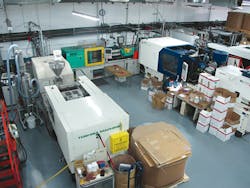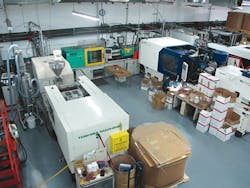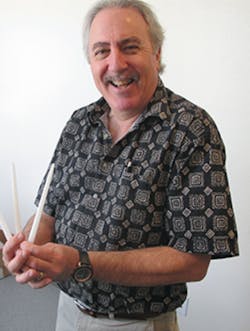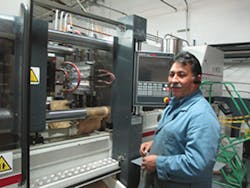Flexibility and diversity in manufacturing, mold design and automation have helped C&G Mercury Plastics Inc. thrive through the decades.
Since its founding in 1947, the family-owned custom injection molder has witnessed and participated in the whirlwind of innovation that nurtured and defined the plastics industry in its home region of Los Angeles. Over the decades, the company, presently in Sylmar, Calif., withstood earthquakes and rapidly changing markets, developing expertise in molding parts other molders wouldn't handle.
C&G Mercury serves a variety of manufacturers, including aerospace, electronics, construction, housewares, toy and sporting goods companies. Companies representing each market segment at one time set up shop in neighboring areas. C&G Mercury advanced its molding know-how serving diverse markets, which ranged from startups to multinational Fortune 500 companies.
Adding value to a product from the design stage through the molding stage keeps the company active. C&G Mercury produces a variety of flexible and rigid packaging and parts in a range of sizes and geometries.
"We consider ourselves to be a service provider rather than a custom molder. We provide a service called plastics manufacturing, and this viewpoint allows us to specialize in providing exacting part quality regardless of part quantity or complexity," said President Greg Leighton. The company's motto, "Unusual is not unusual to us," defines how the molder has operated. Utilizing a range of materials, machinery, molds and methods has helped C&G Mercury attack new and existing markets.
SMALL AND FLEXIBLE
C&G Mercury performs production within 8,000 square feet. It employs 33 people — 20 machine operators, four technicians, one tooling specialist and eight administrative and management staff members — and runs three shifts around the clock five days a week. The majority of the building houses manufacturing, tooling and inventory. Guests are welcomed into modest offices at the front of the facility. C&G Mercury has a mezzanine in the manufacturing space for additional storage.
"We operate similar to a consumer electronics store with experts on the show floor. It costs nothing to sit with an expert to talk about your needs, with the gamble being that you will do business with us afterward. We know what it takes to design, mold and sell a product, and we can determine the precise amount and level of technology," said Leighton.
C&G Mercury generates about $3 million in revenue annually through its part and mold design division, injection molding operations and secondary reworking and assembly operations. It operates eight injection presses with clamping forces ranging from 5 to 330 tons. This includes a hand-operated Morgan vertical press (with simple push buttons for clamping and injection, and knobs to set the pressure and the timer). The molder has horizontal all-electric and hybrid injection molding machines from Arburg, Negri Bossi, Haitian, Toshiba and Sumitomo.
The company can manufacture parts at low volumes and still be profitable, which has helped it secure business in new and emerging markets making toys and aerospace and consumer products. Its jobs are scaleable — with runs requiring anything from a bucketful of resin to gaylords of material — and it has found ways to be flexible. "The key is understanding venting and gating. I understand these concepts, and that makes it possible for us to consider molding parts from a range of materials that other processors would not consider," said Leighton.
FIRST MOLDER TO…
C&G Mercury was among the first companies to injection mold theater marquee lights, as an alternative to compression molding with acrylic or die cut molding. Its list of plastic firsts continued in other market segments. It was also one of the first companies to mold test tubes from PC, and use plexiglass rather than glass in the production of a canopy for an airplane.
"My uncle's contacts in aerospace, with companies like Douglas Aircraft, Lockheed, Lear, Northrup, TRW, Gulfstream, Hughes and Boeing, secured numerous RFQ's (request for quotes) and we did many oddball projects," Leighton said. The customer was more interested in part quality than cycle time.
"Aerospace was a high plastics volume but low tooling volume market. If we had the project to mold a knob, we would mold 200 of each knob, because there were only so many planes back then [1940s]. However, the cockpit would have 20 different types of knobs. So the plastic resin consumption could be sizeable, but most of the tooling for each knob was low volume," he said.
The company also tried out thermoset molding, extrusion and blow molding, but returned its full focus to injection molding.
C&G Mercury claims to be one of the first companies to process urethane resins as a replacement material in wheels for skates and skateboards made from steel or compressed rubber. The company initially molded parts from urethane for a table-top projector for Technicolor.
"Urethane was tricky to mold, and California was a humid and hot place. In the early days, the high moisture in the air impacted molding; after 20 shots, air pockets would form in the wheels, and when the part cooled, water would collect inside the wheels," said Leighton.
As youths, Leighton and some friends, who were avid skaters, debuted the urethane wheels. A local skate shop helped promote the new wheels, as well. Leighton said some of his high school classmates, with whom he had skateboarded, went on to become known as the Lords of Dogtown, the southern California teenagers who revolutionized the skateboarding world and were immortalized in a 2005 movie of the same name.
C&G Mercury Plastics gets its name from the joining of plastics businesses owned by Greg's father, Charles "Chuck," and Greg's uncle, Bill Rhoads. Greg Leighton's father founded his company as Chuck & Sons, then called it Leighton & Sons, before renaming the company C&G Plastics for himself and his son. Rhoads started Mercury Plastics in 1947; that business primarily served the aerospace industry.
AUTOMATION FREES PERSONNEL
Leighton says automation is a key move for the company, and earlier this year it purchased its first five-axis robot. The Sepro unit will be used for machine tending and part take-out operations in applications where multiple components for an assembled product will be produced on machines next to each other.
"The five-axis robot will remove the part from the mold and transfer it to a fixture where personnel handle a value-added function," said GM Jesus Hernandez. Previously, two people were used in this molding cell; one person would reach between the mold halves and pull the part and the runner, placing the part onto the fixture. A second person would perform the post-mold operation. "Automating part takeout improves overall plant efficiency. The person who pulled the part can now be reassigned to another value-added task," says Hernandez. Adding robotic automation will expand C&G Mercury's ability to handle more complex insert molding applications.
C&G Mercury places an emphasis on secondary assembly operations and part reworking for quality improvement. Employees are trained to implement whatever value-added operation is necessary — from press-side inspection to assembly and packing. The materials handling equipment is portable from press to press. C&G Mercury has not standardized with a single vendor for any aspect of its molding operations. Its ancillary equipment, like the injection molding presses, is sourced from a range of companies.
C&G Mercury's molding department cleans and maintains the one- to 32-cavity single-face tools that typically pass through the shop. Racks that hold the molds are located strategically, in three or four separate areas. Mold design software is used to ensure part fill and quality.
C&G Mercury is looking for added functionality in its molding machines as well. Its recent injection machine purchases have all been electric machines in order to combine energy savings with higher molding precision. It purchased two all-electric Zhafir Venus presses in 2011 and two hybrid Negri Bossi units last year.
Machines with the ability to carry out unique operations, like a coining step, transfer that step from a secondary operation into the molding machine, helping to increase molding capability, Leighton said.
Turning concepts into reality is a major theme for the company. "We are a service provider and can do what the customer needs us to do," Leighton said. In one application, a part is unscrewed from the tool by hand, in order to keep the part free of threads, following the customer's request. C&G Mercury has molded parts with a zero draft angle, in which the product is pulled off the core manually.
Leighton keeps a showcase in his office that he dubs the shelf of shame and success. Projects that were successfully molded but never found a commercial audience sit next to products that have been developed or failed. The showcase reminds Leighton to remain flexible as a service provider. "Failures" include a CD/DVD jewel case with a sliding element, which came to market as MP3 digital media took over, and a combination food and water bowl for pets made from PP that failed to launch due to limited advertising, said Leighton.
Mikell Knights, senior correspondent
Contact:
C&G Mercury Plastics Inc., 818-837-3773, www.cgplastics.net




